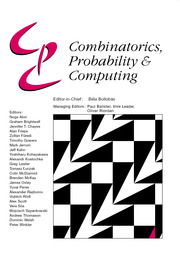Article contents
Defective and clustered choosability of sparse graphs
Published online by Cambridge University Press: 12 April 2019
Abstract
An (improper) graph colouring has defect d if each monochromatic subgraph has maximum degree at most d, and has clustering c if each monochromatic component has at most c vertices. This paper studies defective and clustered list-colourings for graphs with given maximum average degree. We prove that every graph with maximum average degree less than (2d+2)/(d+2)k is k-choosable with defect d. This improves upon a similar result by Havet and Sereni (J. Graph Theory, 2006). For clustered choosability of graphs with maximum average degree m, no (1-ɛ)m bound on the number of colours was previously known. The above result with d=1 solves this problem. It implies that every graph with maximum average degree m is  $\lfloor{\frac{3}{4}m+1}\rfloor$-choosable with clustering 2. This extends a result of Kopreski and Yu (Discrete Math., 2017) to the setting of choosability. We then prove two results about clustered choosability that explore the trade-off between the number of colours and the clustering. In particular, we prove that every graph with maximum average degree m is
$\lfloor{\frac{3}{4}m+1}\rfloor$-choosable with clustering 2. This extends a result of Kopreski and Yu (Discrete Math., 2017) to the setting of choosability. We then prove two results about clustered choosability that explore the trade-off between the number of colours and the clustering. In particular, we prove that every graph with maximum average degree m is  $\lfloor{\frac{7}{10}m+1}\rfloor$-choosable with clustering 9, and is
$\lfloor{\frac{7}{10}m+1}\rfloor$-choosable with clustering 9, and is  $\lfloor{\frac{2}{3}m+1}\rfloor$-choosable with clustering O(m). As an example, the later result implies that every biplanar graph is 8-choosable with bounded clustering. This is the best known result for the clustered version of the earth–moon problem. The results extend to the setting where we only consider the maximum average degree of subgraphs with at least some number of vertices. Several applications are presented.
$\lfloor{\frac{2}{3}m+1}\rfloor$-choosable with clustering O(m). As an example, the later result implies that every biplanar graph is 8-choosable with bounded clustering. This is the best known result for the clustered version of the earth–moon problem. The results extend to the setting where we only consider the maximum average degree of subgraphs with at least some number of vertices. Several applications are presented.
MSC classification
Information
- Type
- Paper
- Information
- Copyright
- © Cambridge University Press 2019
References
- 9
- Cited by

